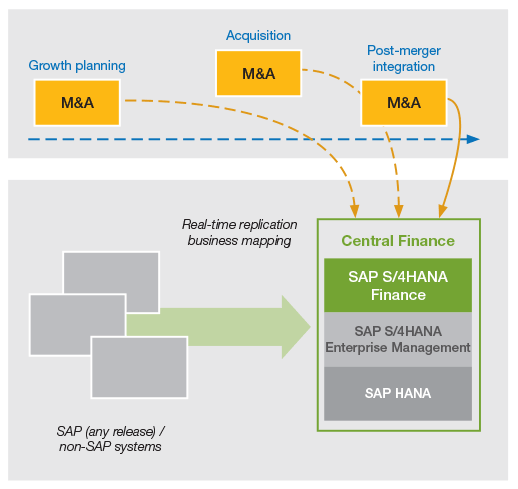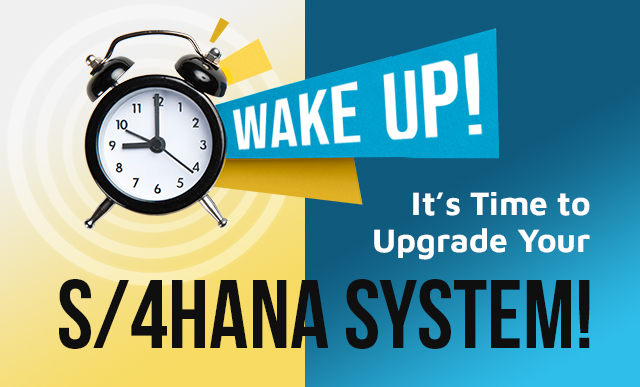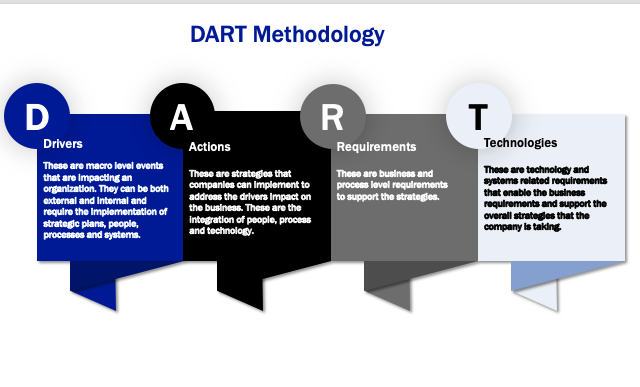Take Control of Mergers and Acquisitions
How a Central Hub for Finance Reduces Complexity and Fast-Tracks Onboarding
As organizations seek to grow in the digital age, the business world has seen a significant uptick in mergers and acquisitions (M&A). Companies are plugging holes or adding capabilities by bringing aboard companies to diversify, specialize, or grow in emerging business areas. But in doing so, organizations are faced with additional and diverse technology being added to what are already complex system landscapes.
This presents several challenges. Advanced consolidated reporting and central process execution become exceedingly difficult, as decentralized, isolated systems create a less-than-ideal environment for detailed planning. A heterogeneous landscape also puts a premium on institutional knowledge, which can make standardization — and a move to a shared services environment — a difficult proposition. In addition, a decentralized system can hinder a company’s evolution onto a digital platform; for organizations that tie finance to an integrated business network, or for those seeking greater flexibility with a hybrid cloud model, decentralization would mean having to integrate software-as-a-service (SaaS) applications with a host of source systems.
For SAP S/4HANA customers active in the M&A game, there is a more efficient way to onboard new businesses with minimal disruption while also enabling central process execution and consolidated entity reporting — by using the Central Finance deployment option as a dedicated M&A hub.
Take the Complexity Out of M&A
Central Finance is an accelerated, non-disruptive SAP S/4HANA deployment option where financial transactions from SAP and non-SAP ERP source systems are replicated onto a Central Finance instance that runs on SAP S/4HANA (see Figure 1).

As an M&A hub, Central Finance supports rapid, non-disruptive M&A activity. And, because Central Finance runs on SAP S/4HANA, companies that use it as the foundation for an M&A hub reap all the rewards of the structural changes in SAP S/4HANA that distinguish the next-generation platform from legacy ERP systems. These benefits include the combination of online transaction processing (OLTP) and online analytical processing (OLAP) functions on a single database, which means that processes such as financial accounting (FI) and controlling (CO) that are involved with more than one source can be viewed as a singular entity, thus reducing process execution complexity and eliminating the need for error-prone reconciliations. Additional benefits include increased performance for both analytics and transactions in a columnar data storage model, which eliminates the need for secondary indices, summary tables, and aggregates.
Structural enhancements aside, SAP S/4HANA allows for a non-disruptive path for M&A consolidation because by setting up a separate, dedicated SAP S/4HANA instance for finance only — a “light” version of SAP S/4HANA, if you will — companies can achieve a holistic, central view of finance across the organization without bringing in logistics and other pieces of the business. This helps to reduce onboarding complexity, as important decisions about integrating full-scale operations can be delayed until a clear finance picture emerges.
Finance takes the lead, then, in forging a path forward based on actuals. Resource-intensive planning exercises to calculate how a potential M&A activity will affect an organization’s financial health can be supported by integrating source finance systems with a dedicated M&A hub on Central Finance.
Create a Repeatable Template
One important advantage of Central Finance as an M&A hub is that by supporting central process execution and advanced, consolidated reporting, organizations are freed from having to make the difficult decision to onboard a new source system, either in the short term or long term. In fact, data harmonization and mapping activity can be done over time in accordance with the strategic plans for each new acquisition.
At the same time, taking the steps to create a repeatable onboarding template or playbook — one that is specifically designed to enable all integrated planning capabilities on a single, dedicated Central Finance instance — will consolidate and standardize reporting regardless of plans to decommission a source system. Thus, in documenting the onboarding of an initial source system, an organization can either re-execute the steps in future onboarding activity, or, conversely, have a template for initial data harmonization efforts that can pave the way toward a shared services environment, as well as standardize reporting.
Prior to the merger, then, organizations can use Central Finance as an M&A hub to enable integration planning using the embedded financial planning tools in SAP S/4HANA to create a plan as a foundation for the post-merger integration. With financial data from both companies in Central Finance, and having optimized this dedicated SAP S/4HANA instance to support integration with multiple source systems, a company can then execute against its plan as soon as merger activity begins.
A Next-Generation Digital Platform
Post-merger integration with an M&A hub on Central Finance offers a few key advantages. From a purely functional standpoint, SAP S/4HANA supports faster and more efficient transactional processing and enhanced analytics capabilities with SAP Fiori as an improved user interface (UI) over what many organizations now expect. And because Central Finance can leverage a shared services framework for process orchestration, the resulting central process execution eliminates the need to execute transactions in various source systems.
Additionally, enhanced SAP S/4HANA capabilities in the 1605 and 1610 releases include functionality for central credit, dispute, and collection management. These new releases are also paving the way for central accounts payable (AP) and accounts receivable (AR) functionality. Because embedded financial planning and real-time consolidation capabilities are a native part of a Central Finance instance, record-to-report activities can all take place on the one dedicated instance rather than various source systems.
This functionality eliminates the need for companies involved in M&A activity to connect a new source system with a separate data warehouse, for example, or to have to support and maintain various planning and consolidation applications. With everything in Central Finance, further simplification is achieved simply by reducing the number of interfaces.
An Agile Framework
Another advantage of using Central Finance as an M&A hub for consolidated reporting and central process execution is the ability to add dimensions and maintain business model mappings when replicating data between a source system and Central Finance. If a company wishes to do a profitability analysis, for example, on elements previously not captured, such as a vehicle in automotive or an article in retail, Central Finance makes it easy to add or remap dimension value, such as account, customer, or profit center. Typically, this would only be possible to do in each source system by overwriting legacy values, or by creating yet another set of reports not integrated with existing reporting, process execution, planning, and consolidation applications. Because Central Finance enables modeling and simulations all on the same single-source-of-truth financial data repository (the universal journal in Central Finance), it significantly reduces the time and effort to provide business-critical financial and management accounting insight.
Having the capability to do profitability analysis on the fly is a prime example of the enhanced agility that is a requirement for any organization that is serious about undertaking a digital evolution. While this is true with or without M&A activity on the horizon, it’s something of a chicken-and-egg scenario; becoming more agile opens up M&A opportunity, while at the same time integrated business networks and a digital economy are forcing organizations to become more agile.
Fast-Track M&A Onboarding
In the past, it had been customary for organizations involved with M&A activity to plan for an onboarding process of at least several months. Procuring hardware, integration activities, and data harmonization were just a handful of the various challenges that emerged when bringing on a new source system.
This is not the case with Central Finance as an M&A hub for a few reasons. First, as a light version of SAP S/4HANA, where only finance is brought in from the source system to SAP S/4HANA, an acquisition can move forward without having to integrate all of a company’s mission-critical business processes. Furthermore, Central Finance supports a third-party integration framework for integrating with non-SAP source systems, minimizing the need for extensive customizations. In fact, SAP partners currently offer pre-built templates to connect non-SAP source systems to SAP S/4HANA on Central Finance via customizations in a matter of 5-10 days. Without a pre-built template, it might take months to custom-build for even more complex acquisitions.
But as we’ve already explored, Central Finance takes complexity out of remapping efforts by making it easy to change dimensions, meaning an acquisition does not need to be held up until all data harmonization activity is complete with one-to-one mapping for all finance activity. Improvements and changes can be made over time in a phased central process execution approach. With Central Finance, this is actually a preferred model, as enhanced visibility often leads to a decision to design things differently anyway; companies tackling data quality, for example, may have developed data quality rules with a typical ERP system in mind. With the structural changes in SAP S/4HANA moving everything to the application layer, data quality would likely be done differently, leading to post-merger adjustments. Enhanced flexibility ensures that many acquisition activities can be done as a moving target, with on-the-fly optimizations part and parcel of Central Finance as an M&A hub use case.
Central Finance as an M&A hub changes most pre-conceived notions of what an acquisition entails, and this certainly holds true from a regulatory perspective. Generally speaking, announcing the intent to acquire permits organizations to exchange data structures, but not accompanying value, giving them time to work out an integration and mapping framework prior to the close. Central Finance as an M&A hub significantly accelerates this process by moving integrations and mappings to this dedicated SAP S/4HANA instance, which means that when the acquisition is final, an organization can produce a consolidated financial statement on day one rather than having to wait a few months and potentially be in for a big surprise. And, because companies have the option of standing up a Central Finance instance of SAP S/4HANA in the cloud, an acquisition project can begin just as soon as the intent to acquire is announced, without having to build in additional time to acquire hardware and install the infrastructure.
The Future of M&A
Using Central Finance as a dedicated M&A hub can fundamentally change how organizations decide to move forward with M&A activity. Acquisitions no longer need to result in having to support and maintain a decentralized network of source systems that fail to provide a single source of truth of an organization’s finances. Nor do they need to result in complex onboarding projects in an effort to arrive at central process execution.
Central Finance as an M&A hub provides organizations with unparalleled flexibility and functionality on a next-generation digital platform and can help shape an organization’s M&A strategy as a key part of continuing on a digital evolution.








